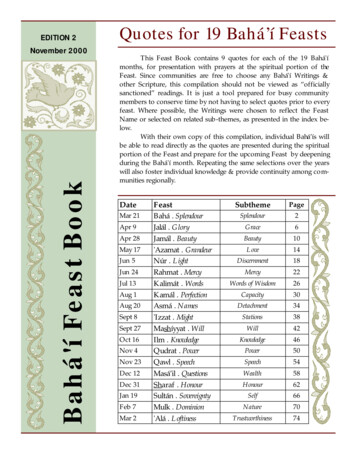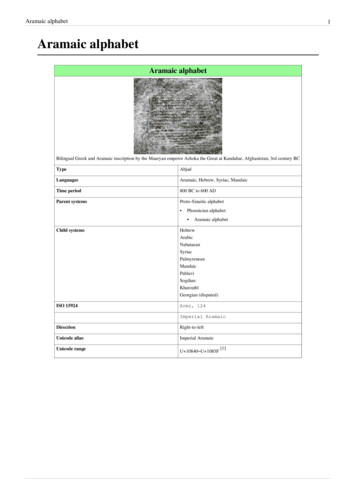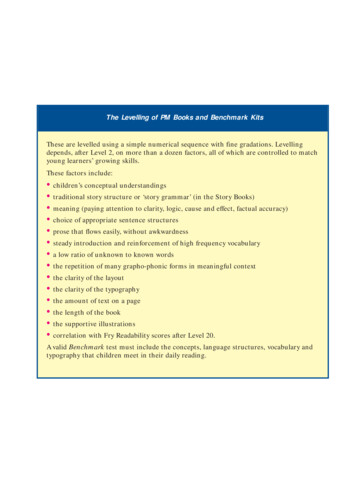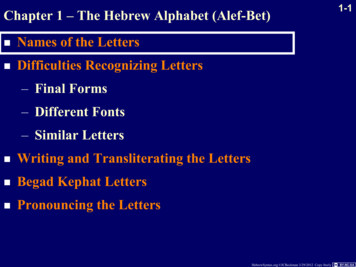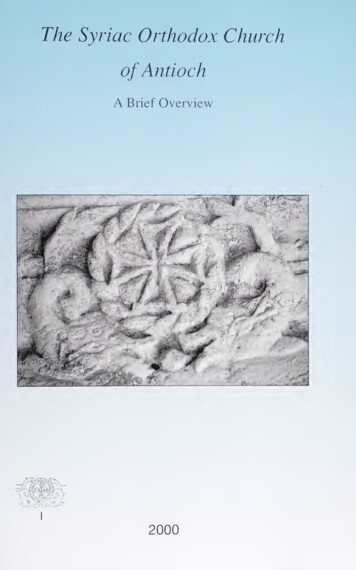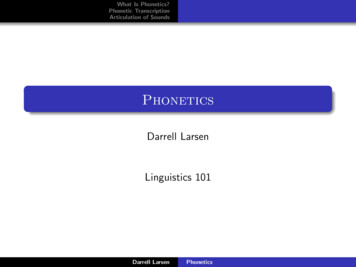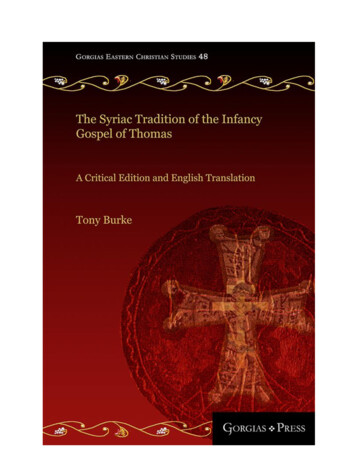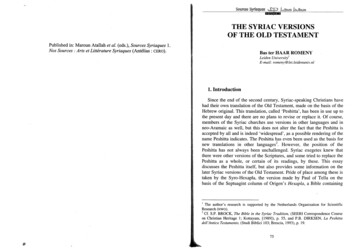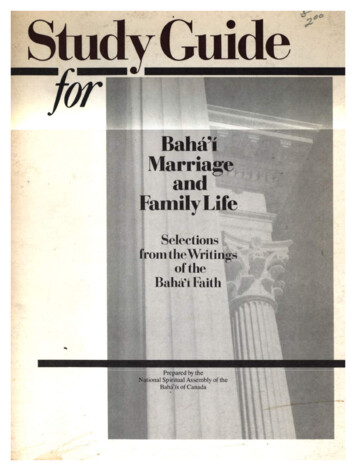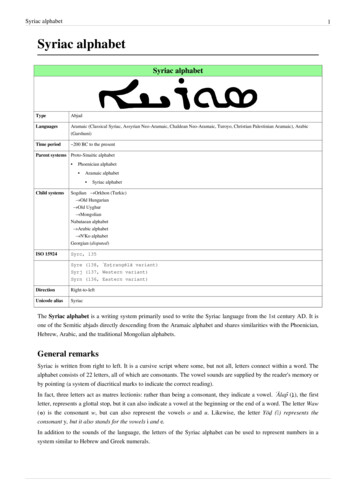
Transcription
Syriac alphabet1Syriac alphabetSyriac alphabetTypeAbjadLanguagesAramaic (Classical Syriac, Assyrian Neo-Aramaic, Chaldean Neo-Aramaic, Turoyo, Christian Palestinian Aramaic), Arabic(Garshuni)Time period 200 BC to the presentParent systems Proto-Sinaitic alphabet Phoenician alphabet Aramaic alphabet Syriac alphabetChild systemsSogdian Orkhon (Turkic) Old Hungarian Old Uyghur MongolianNabataean alphabet Arabic alphabet N'Ko alphabetGeorgian (disputed)ISO 15924Syrc, 135Syre (138, ʾEsṭrangēlā variant)Syrj (137, Western variant)Syrn (136, Eastern variant)DirectionRight-to-leftUnicode aliasSyriacThe Syriac alphabet is a writing system primarily used to write the Syriac language from the 1st century AD. It isone of the Semitic abjads directly descending from the Aramaic alphabet and shares similarities with the Phoenician,Hebrew, Arabic, and the traditional Mongolian alphabets.General remarksSyriac is written from right to left. It is a cursive script where some, but not all, letters connect within a word. Thealphabet consists of 22 letters, all of which are consonants. The vowel sounds are supplied by the reader's memory orby pointing (a system of diacritical marks to indicate the correct reading).In fact, three letters act as matres lectionis: rather than being a consonant, they indicate a vowel. ʾĀlap̄ ( )ܐ , the firstletter, represents a glottal stop, but it can also indicate a vowel at the beginning or the end of a word. The letter Waw( )ܘ is the consonant w, but can also represent the vowels o and u. Likewise, the letter Yōḏ ( )ܝ represents theconsonant y, but it also stands for the vowels i and e.In addition to the sounds of the language, the letters of the Syriac alphabet can be used to represent numbers in asystem similar to Hebrew and Greek numerals.
Syriac alphabet2When Arabic began to be the dominant spoken language in the Fertile Crescent, texts were often written in Arabicwith the Syriac script. These writings are usually called Karshuni or Garshuni ( )ܓܪܫܘܢܝ . Garshuni is often usedtoday by Neo-Aramaic speakers in written communication such as letters and fliers.Forms of the Syriac alphabetThere are three major variants of the Syriacalphabet.Classical ʾEsṭrangēlāThe oldest and classical form of the alphabetis ʾEsṭrangēlā ( ;ܐܣܛܪܢܓܠܐ the name isthought to derive from the Greek adjectiveστρογγύλη (strongylē, 'rounded'),[1] thoughit has also been suggested to derive from ( ܣܪܛܐ ܐܘܢܓܠܝܐ serṭā ’ewangēlāyā, 'gospelcharacter')[2]). Although ʾEsṭrangēlā is nolonger used as the main script for writingSyriac, it has received some revival sincethe 10th century. It is often used in scholarly11th century book in Syriac Serṭā.publications (for instance, the LeidenUniversity version of the Peshitta), in titlesand inscriptions. In some older manuscripts and inscriptions it is possible for any letter to join to the left, and olderAramaic letter forms (especially of Ḥeth and the lunate Mem) are found. Vowel marks are usually not used withʾEsṭrangēlā.East Syriac MaḏnḥāyāThe East Syriac dialect is usually written in the Maḏnḥāyā ( ܡܲܕ݂ܢܚܵܝܵܐ , 'Eastern') form of the alphabet. Other namesfor the script include Swāḏāyā ( ܣܘܵܕ݂ܵܝܵܐ , 'conversational', often translated as 'contemporary', reflecting its use inwriting modern Neo-Aramaic), 'Assyrian' (not to be confused with the traditional name for the Hebrew alphabet),'Chaldean', and, inaccurately, 'Nestorian' (a term that was originally used to refer to the Church of the East in thePersian Empire). The Eastern script resembles ʾEsṭrangēlā more closely than the Western script, being somewhat amidway point between the two. The Eastern script uses a system of dots above or below letters, based on an oldersystem, to indicate vowels: A dot above and a dot below a letter represent [a], transliterated as a or ă ( ܦܬ݂ܵܚܵܐ , Pṯāḥā), Two diagonally-placed dots above a letter represent [ɑ], transliterated as ā or â or å ( ܙܩܵܦ݂ܵܐ , Zqāp̄ā), Two horizontally-placed dots below a letter represent [ɛ], transliterated as e or ĕ ( ܪܒ݂ܵܨܵܐ ܐܲܪܝܼܟ݂ܵܐ , Rḇāṣā ărīḵā or ܙܠܵܡܵܐ ܦܫܝܼܩܵܐ , Zlāmā pšīqā; often pronounced [ɪ] and transliterated as i in the East Syriac dialect), Two diagonally-placed dots below a letter represent [e], transliterated as ē ( ܪܒ݂ܵܨܵܐ ܟܲܪܝܵܐ , Rḇāṣā karyā or ܙܠܵܡܵܐ ܩܲܫܝܵܐ , Zlāmā qašyā), A letter Yōḏ with a dot beneath it represents [i], transliterated as ī or i ( ܚܒ݂ܵܨܵܐ , Ḥḇāṣā), A letter Waw with a dot below it represents [u], transliterated as ū or u ( ܥܨܵܨܵܐ ܐܲܠܝܼܨܵܐ , ʿṢāṣā ălīṣā or ܪܒ݂ܵܨܵܐ ,Rḇāṣā), A letter Waw with a dot above it represents [o], transliterated as ō or o ( ܪܘܝܼܚܵܐ Rwāḥā). ܥܨܵܨܵܐ , ʿṢāṣā rwīḥā or ܪܘܵܚܵܐ ,
Syriac alphabet A combination of Rḇāṣā karyā (usually) followed by a letter Yōḏ represents [e] (possibly *[e̝] in Proto-Syriac),transliterated as ē or ê ( ܐܲܣܵܩܵܐ , ʾĂsāqā).It is thought that the Eastern method for representing vowels influenced the development of the Niqqud markingsused for writing Hebrew.In addition to the above vowel marks, transliteration of Syriac sometimes includes ə, e̊ or superscript e (or oftennothing at all) to represent an original Aramaic schwa that became lost later on at some point in the development ofSyriac. Some transliteration schemes find its inclusion necessary for showing spirantization (see below) or forhistorical reasons. Whether because its distribution is mostly predictable (usually inside a syllable-initialtwo-consonant cluster) or because its pronunciation was lost, neither the East nor West variants of the alphabet havea sign to represent the schwa.West Syriac SerṭāThe West Syriac dialect is usuallywritten in the Serṭā ( ܣܶܪܛܳܐ , 'line')form of the alphabet, also known as thePšīṭā ( ܦܫܺܝܛܳܐ , 'simple'), 'Maronite',or the 'Jacobite' script (although thetermJacobiteisconsideredThe opening words of the Gospel of John written in Serṭā, Maḏnḥāyā and ʾEsṭrangēlā (topderogatory). Most of the letters areto bottom) — brēšiṯ iṯaw[hy]-[h]wā melṯā, 'in the beginning was the word'.clearly derived from ʾEsṭrangēlā, butare simplified, flowing lines. Acursive, chancery hand is evidenced in the earliest Syriac manuscripts, but important works were written inʾEsṭrangēlā. From the 8th century, the simpler Serṭā style came into fashion, perhaps because of its more economicaluse of parchment. The Nabataean alphabet (which gave rise to the Arabic alphabet) was based on this form of Syriachandwriting. The Western script is usually vowel-pointed with miniature Greek vowel letters above or below theletter which they follow: Capital Alpha (Α) represents [a], transliterated as a or ă ( ܦܬ݂ܳܚܳܐ , Pṯāḥā), Lowercase Alpha (α) represents [ɑ], transliterated as ā or â or å ( ܙܩܳܦ݂ܳܐ , Zqāp̄ā; pronounced as [o] andtransliterated as o in the West Syriac dialect), Lowercase Epsilon (ε) represents both [ɛ], transliterated as e or ĕ, and [e], transliterated as ē ( ܪܒ݂ܳܨܳܐ , Rḇāṣā), Capital Eta (H) represents [i], transliterated as ī ( ܚܒ݂ܳܨܳܐ , Ḥḇāṣā), A combined symbol of capital Upsilon (Υ) and lowercase Omicron (ο) represents [u], transliterated as ū or u( ܥܨܳܨܳܐ , ʿṢāṣā). Lowercase Omega (ω), used only in the vocative interjection ʾō ( ّܐܘ , 'O!').Summary tableThe Syriac alphabet consists of the following letters, shown in their isolated (non-connected) forms. When isolated,the letters Kāp̄, Mīm, and Nūn are usually shown with their initial form connected to their final form (see below).The letters ʾĀlap̄, Dālaṯ, Hē, Waw, Zayn, Ṣāḏē, Rēš, and Taw (and, in early ʾEsṭrangēlā manuscripts, the letterSemkaṯ[3]) do not connect to a following letter within a word when written. These are marked with an asterisk (*).3
Syriac alphabetName4LetterʾEsṭrangēlā Maḏnḥāyā SerṭāSound ValueNumerical Phoenician HebrewArabicValueEquivalent Equivalent EquivalentTransliterationIPAʾĀlap̄* ( )ܐܠܦ ʾ or nothing[ʔ]or silent1႐ א ﺍ Bēṯ ( )ܒܝܬ hard: bsoft: ḇ (also bh, v, β)hard: [b]soft: [v] or [w]2႐ ב ﺏ Gāmal( )ܓܡܠ hard: gsoft: ḡ (also g̱, gh, ġ,γ)hard: [ɡ]soft: [ɣ]3႐ ג ﺝ , ﻍ Dālaṯ*( )ܕܠܬ hard: dsoft: ḏ (also dh, ð, δ)hard: [d]soft: [ð]4႐ ד ﺩ , ﺫ Hē* ( )ܗܐ h[h]5႐ ה ﻩ Waw* ( )ܘܘ consonant: wmater lectionis: ū orō(also u or o)consonant: [w]mater lectionis: [u]or [o]6႐ ו ﻭ Zayn* ( )ܙܝܢ z[z]7႐ ז ﺯ Ḥēṯ ( )ܚܝܬ ḥ[ħ], [x], or [χ]8႐ ח ﺡ , ﺥ Ṭēṯ ( )ܛܝܬ ṭ[tˤ]9႐ ט ﻁ Yōḏ ( )ܝܘܕ consonant: ymater lectionis: ī(also i)consonant: [j]mater lectionis: [i]or [e]10႐ י ﻱ Kāp̄ ( )ܟܦ hard: ksoft: ḵ (also kh, x)hard: [k]soft: [x]20႐ כך ﻙ , ﺥ Lāmaḏ( )ܠܡܕ l[l]30႐ ל ﻝ Mīm ( )ܡܝܡ m[m]40႐ מם ﻡ Nūn ( )ܢܘܢ n[n]50႐ נן ﻥ Semkaṯ( )ܣܡܟܬ s[s]60႐ ס ﺱ ʿĒ ( )ܥܐ ʿ[ʕ]70႐ ע ﻉ Pē ( )ܦܐ hard: psoft: p̄ (also p̱, ᵽ, ph,f)hard: [p]soft: [f]80႑ פף ﻑ Ṣāḏē* ( )ܨܕܐ ṣ[sˤ]90႑ צץ ﺹ Qōp̄ ( )ܩܘܦ q[q]100႑ ק ﻕ Rēš* ( )ܪܝܫ r[r]200႑ ר ﺭ Šīn ( )ܫܝܢ š (also sh)[ʃ]300႑ ש ﺵ Taw* ( )ܬܘ hard: tsoft: ṯ (also th, θ)hard: [t]soft: [θ]400႑ ת ﺕ , ﺙ
Syriac alphabet5Contextual forms of lettersLetterʾEsṭrangēlā (classical)NormalformMaḏnḥāyā (eastern)FinalFinalNormalFinalFinalconnected unconnected form connected ṯ/ʿĒPēṢāḏēQōp̄RēšŠīnTaw1In the final position following Dālaṯ or Rēš, ʾĀlap̄ takes the normal form rather than the final form.
Syriac alphabet6LigaturesNameʾEsṭrangēlā (classical)Unicodecharacter(s)Description ܠܐ Lāmaḏ and ʾĀlap̄combinedat the end of a word ܬܐ Taw and ʾĀlap̄ combinedat the end of a wordHē-Yōḏ ܗܝ Hē and Yōḏ combinedat the end of a wordTaw-Yōḏ ܬܝ Taw and Yōḏ combinedat the end of a wordNormalformMaḏnḥāyā (eastern)FinalFinalNormalFinalFinalconnected unconnected form connected unconnectedLāmaḏ-ʾĀlap̄Taw-ʾĀlap̄/Letter alterationsIn modern usage, some alterations can be made to represent phonemes not represented in classical orthography. Amark similar in appearance to a tilde, called Majlīyānā ( )ܡܓ̰ܠܝܢܐ , is placed either above or below a letter in theMaḏnḥāyā variant of the alphabet to change its phonetic value (see also: Geresh): Added to Gāmal: [ɡ] to [d͡ʒ] (voiced postalveolar affricate)Added to Kāp̄: [k] to [t͡ʃ] (voiceless postalveolar affricate)Added to Zayn: [z] to [ʒ] (voiced postalveolar fricative)Added to Šīn: [ʃ] to [ʒ]In addition to foreign sounds, a marking system is used to distinguish qūššāyā ( ܩܘܫܝܐ , 'hard' letters) from rūkkāḵā( ܪܘܟܟܐ , 'soft' letters). The letters Bēṯ, Gāmal, Dālaṯ, Kāp̄, Pē, and Taw, all plosives ('hard'), are able to bespirantized into fricatives ('soft'). The system involves placing a single dot underneath the letter to give its 'soft'variant and a dot above the letter to give its 'hard' variant (though, in modern usage, no mark at all is usually used toindicate the 'hard' value):NameBēṯ (qšīṯā)Gāmal (qšīṯā)Dālaṯ (qšīṯā)Kāp̄ (qšīṯā)Pē (qšīṯā)Taw (qšīṯā)Plosive Translit. IPAName݁ ܒ b[b]Bēṯ rakkīḵtā݁ ܓ ݁ ܕ ݁ ܟ݁ܟ ݁ ܦ g[ɡ] Gāmal rakkīḵtād[d]Dālaṯ rakkīḵtāk[k]Kāp̄ rakkīḵtāp[p]Pē rakkīḵtā݁ ܬ tSpirant Translit. IPA݂ ܒ ḇ[v]or[w]݂ ܓ ݂ ܕ ݂ ܟ݂ܟ ݂ ܦ ̮ ܦ ḡ[ɣ]ḏ[ð]ḵ[x]݂ ܬ ṯp̄or[t]Taw rakkīḵtāNotes[v] has become [w] in most modern dialects.[d] is left unspirantized in some modern Eastern dialects.[f] or [f] is not found in most modern Eastern dialects. Instead, it[w] either is left unspirantized or sometimes appears as [w]. Pēis the only letter in the Eastern variant of the alphabet thatis spirantized by the addition of a semicircle instead of asingle dot.[θ][t] is left unspirantized in some modern Eastern dialects.The mnemonic bḡaḏkp̄āṯ ( )ܒܓܕܟܦܬ is often used to remember the six letters that are able to be spirantized (see also:Begadkefat).
Syriac alphabet7In the East Syriac variant of the alphabet, spirantization marks are usually omitted when they interfere with vowelmarks. The degree to which letters can be spirantized varies from dialect to dialect as some dialects have lost theability for certain letters to be spirantized. For native words, spirantization depends on the letter's position within aword or syllable, location relative to other consonants and vowels, gemination, etymology, and other factors. Foreignwords are not always subject to the rules for spirantization.UnicodeThe Syriac alphabet was added to the Unicode Standard in September, 1999 with the release of version 3.0.BlockThe Unicode block for Syriac is U 0700 . U 074F:Syriac[1]Unicode.org chart [4] (PDF)U 070xU 071xU 072xU 073xU 074x0 ܀ ܐ ܠ ܰ݀1 ܁ ܑ ܡ ܱ݁2 ܂ ܒ ܢ ݂ܲ3 ܃ ܓ ܣ ܳ݃4 ܄ ܔ ܤ ܴ݄5 ܅ ܕ ܥ ܵ݅6 ܆ ܖ ܦ ݆ܶ7 ܇ ܗ ܧ ܷ݇8 ܈ ܘ ܨ ܸ݈9 ܉ ܙ ܩ ܹ݉A ܊ ܚ ܪ ܺ݊B ܋ ܛ ܫ ܻC ܌ ܜ ܬ ܼD ܍ ܝ ܭ ܽ ݍ E F ܞ ܮ ܾ ݎ ܟ ܯ ܿ ݏ Notes1. As of Unicode version 6.3The Syriac Abbreviation (a type of overline) can be represented with a special control character called the SyriacAbbreviation Mark (U 070F).HTML code tableNote: HTML numeric character references can be in decimal format (&#DDDD;) or hexadecimal format(&#xHHHH;). For example, ܕ and ܕ (1813 in hexadecimal) both represent U 0715 SYRIACLETTER DALATH.ʾĀlap̄ Bēṯ ܕ ܓ ܒ ܐ ܕ ܓ ܒ ܐ ܚ ܙ ܘ ܗ ܚ ܙ ܘ ܗ ܠ ܟܟ ܝ ܛ ܠ ܟ ܝ ܛ ܥ ܣ ܢܢ ܡܡ ܥ ܤ ܢ ܡ ܪ ܩ ܨ ܦ ܪ ܩ ܨ ܦ
Syriac alphabet8 ܬ ܫ ܬ ܫVowels and unique charactersܲܵܲ ܸܹܸܵ ܹܼܼܿ ̰̰݂ܿ̈̈݁݁ ݂ ܀ ܂ ܀ ܂ ܄ ݇܄ ݇References Coakley, J. F. (2002). Robinson's paradigms and exercises in Syriac grammar (5th ed.). Oxford University Press.ISBN 978-0-19-926129-1. Hatch, William (1946). An album of dated Syriac manuscripts. Boston: The American Academy of Arts andSciences, reprinted in 2002 by Gorgias Press. ISBN 1-931956-53-7. Michaelis, Ioannis Davidis (1784). Grammatica Syriaca. Nestle, Eberhard (1888). Syrische Grammatik mit Litteratur, Chrestomathie und Glossar. Berlin: H. Reuther'sVerlagsbuchhandlung. [translated to English as Syriac grammar with bibliography, chrestomathy and glossary,by R. S. Kennedy. London: Williams & Norgate 1889]. Nöldeke, Theodor and Julius Euting (1880). Kurzgefasste syrische Grammatik. Leipzig: T.O. Weigel. [translatedto English as Compendious Syriac Grammar, by James A. Crichton. London: Williams & Norgate 1904. 2003edition: ISBN 1-57506-050-7]. Phillips, George (1866). A Syriac grammar. Cambridge: Deighton, Bell, & Co.; London: Bell & Daldy. Robinson, Theodore Henry (1915). Paradigms and exercises in Syriac grammar. Oxford University Press. ISBN0-19-926129-6. Rudder, Joshua. Learn to Write Aramaic: A Step-by-Step Approach to the Historical & Modern Scripts. n.p.:CreateSpace Independent Publishing Platform, 2011. 220 pp. ISBN 978-1461021421 Includes the Estrangela (pp.59-113), Madnhaya (pp. 191-206), and the Western Serto (pp. 173-190) scripts. Thackston, Wheeler M. (1999). Introduction to Syriac. Bethesda, MD: Ibex Publishers, Inc. ISBN 0-936347-98-8.
Syriac alphabetFootnotes[1] Hatch, William (1946). An album of dated Syriac manuscripts. Boston: The American Academy of Arts and Sciences, reprinted in 2002 byGorgias Press. p. 24. ISBN 1-931956-53-7.[2] Nestle, Eberhard (1888). Syrische Grammatik mit Litteratur, Chrestomathie und Glossar. Berlin: H. Reuther's Verlagsbuchhandlung.[translated to English as Syriac grammar with bibliography, chrestomathy and glossary, by R. S. Kennedy. London: Williams & Norgate1889. p. 5].[3] Coakley, J. F. (2002). Robinson's paradigms and exercises in Syriac grammar (5th ed.). Oxford University Press. p. 141. ISBN978-0-19-926129-1.[4] http:/ / www. unicode. org/ charts/ PDF/ U0700. pdfExternal links The Syriac alphabet (http://www.omniglot.com/writing/syriac.htm) at Omniglot.com (http://www.omniglot.com/) The Syriac alphabet (http://ancientscripts.com/syriac.html) at Ancientscripts.com (http://ancientscripts.com/index.html) Unicode Entity Codes for the Syriac Script nguage/syriacchart.html) Download Syriac fonts (http://www.wazu.jp/gallery/Fonts Syriac.html) How to write Aramaic - learn the Syriac cursive scripts -writing-cursive.php) Aramaic and Syriac handwriting (http://www.syriac.talktalk.net/syriac writing.html) ʾEsṭrangēlā (classical) Learn Assyrian (Syriac-Aramaic) OnLine (http://www.learnassyrian.com/aramaic/) Maḏnḥāyā (eastern) GNU FreeFont (http://www.gnu.org/software/freefont/) Unicode font family with Syriac range in its serifface.9
Article Sources and ContributorsArticle Sources and ContributorsSyriac alphabet Source: https://en.wikipedia.org/w/index.php?oldid 571378918 Contributors: 334a, 3abos, Amire80, AssyrianJoe, Assyrio, Bit, Brando130, Chaldean, Chris the speller,Cserlajos, Cuaxdon, Cybercobra, Dbachmann, DePiep, DerBorg, Dirkbb, Djwilms, Dmyersturnbull, DopefishJustin, Drmccreedy, Dsmdgold, Elvis214, Emrrans, Epson291, Eras-mus, Felixahlner, Fiveiambline, Flamarande, FrancisTyers, Garzo, Gugganij, Gyopi, Hairy Dude, Hibernian, Hmains, Ichwan Palongengi, Ikiroid, Indexheavy, Irate velociraptor, Izzedine, J R Gainey,Jasonbook99, Kaganer, Kathovo, Koavf, Kwamikagami, Latebird, Laughingyet, Leszek Jańczuk, Mahmudmasri, Meursault2004, Miquonranger03, Monedula, Msleeman, Mustafaa, Pjacobi,PoccilScript, PuzzletChung, Ruakh, Rumping, Sardanaphalus, SchuminWeb, Sinnierer, Stephen C. Carlson, Stevan White, Sumerophile, Takabeg, Throttleryn, Tobias Conradi, Vanisaac,Varlaam, Viking Rollo, Withaynoti, בוקי סריקי , ﺗﺴﻠﯿﻢ , അച്ചായൻ, თეკა, 57 anonymous editsImage Sources, Licenses and ContributorsFile:Syriac Alphabet Sample.svg Source: https://en.wikipedia.org/w/index.php?title File:Syriac Alphabet Sample.svg License: Public Domain Contributors: Ichwan PalongengiFile:Syriac Sertâ book script.jpg Source: https://en.wikipedia.org/w/index.php?title File:Syriac Sertâ book script.jpg License: Public Domain Contributors: AnonMoos, Dbc334, Dsmdgold,Garzo, JMCC1, Mel22, Olivier, Shakko, WeFtFile:SyriacJohn.svg Source: https://en.wikipedia.org/w/index.php?title File:SyriacJohn.svg License: Creative Commons Attribution-ShareAlike 3.0 Unported Contributors: SyriacJohn.png:derivative work:File:Syriac Estrangela alap.svg Source: https://en.wikipedia.org/w/index.php?title File:Syriac Estrangela alap.svg License: Public Domain Contributors: Tasnu ArakunFile:Syriac Eastern alap.svg Source: https://en.wikipedia.org/w/index.php?title File:Syriac Eastern alap.svg License: Public Domain Contributors: Tasnu ArakunFile:Syriac Serta alap.svg Source: https://en.wikipedia.org/w/index.php?title File:Syriac Serta alap.svg License: Public Domain Contributors: Tasnu ArakunFile:Syriac Estrangela bet.svg Source: https://en.wikipedia.org/w/index.php?title File:Syriac Estrangela bet.svg License: Public Domain Contributors: Tasnu ArakunFile:Syriac Eastern bet.svg Source: https://en.wikipedia.org/w/index.php?title File:Syriac Eastern bet.svg License: Public Domain Contributors: Tasnu ArakunFile:Syriac Serta bet.svg Source: https://en.wikipedia.org/w/index.php?title File:Syriac Serta bet.svg License: Public Domain Contributors: Tasnu ArakunFile:Syriac Estrangela gamal.svg Source: https://en.wikipedia.org/w/index.php?title File:Syriac Estrangela gamal.svg License: Public Domain Contributors: Tasnu ArakunFile:Syriac Eastern gamal.svg Source: https://en.wikipedia.org/w/index.php?title File:Syriac Eastern gamal.svg License: Public Domain Contributors: Tasnu ArakunFile:Syriac Serta gamal.svg Source: https://en.wikipedia.org/w/index.php?title File:Syriac Serta gamal.svg License: Public Domain Contributors: Tasnu ArakunFile:Syriac Estrangela dalat.svg Source: https://en.wikipedia.org/w/index.php?title File:Syriac Estrangela dalat.svg License: Public Domain Contributors: Tasnu ArakunFile:Syriac Eastern dalat.svg Source: https://en.wikipedia.org/w/index.php?title File:Syriac Eastern dalat.svg License: Public Domain Contributors: Tasnu ArakunFile:Syriac Serta dalat.svg Source: https://en.wikipedia.org/w/index.php?title File:Syriac Serta dalat.svg License: Public Domain Contributors: Tasnu ArakunFile:Syriac Estrangela he.svg Source: https://en.wikipedia.org/w/index.php?title File:Syriac Estrangela he.svg License: Public Domain Contributors: Tasnu ArakunFile:Syriac Eastern he.svg Source: https://en.wikipedia.org/w/index.php?title File:Syriac Eastern he.svg License: Public Domain Contributors: Tasnu ArakunFile:Syriac Serta he.svg Source: https://en.wikipedia.org/w/index.php?title File:Syriac Serta he.svg License: Public Domain Contributors: Tasnu ArakunFile:Syriac Estrangela waw.svg Source: https://en.wikipedia.org/w/index.php?title File:Syriac Estrangela waw.svg License: Public Domain Contributors: Tasnu ArakunFile:Syriac Eastern waw.svg Source: https://en.wikipedia.org/w/index.php?title File:Syriac Eastern waw.svg License: Public Domain Contributors: Tasnu ArakunFile:Syriac Serta waw.svg Source: https://en.wikipedia.org/w/index.php?title File:Syriac Serta waw.svg License: Public Domain Contributors: Tasnu ArakunFile:Syriac Estrangela zayn.svg Source: https://en.wikipedia.org/w/index.php?title File:Syriac Estrangela zayn.svg License: Public Domain Contributors: Tasnu ArakunFile:Syriac Eastern zayn.svg Source: https://en.wikipedia.org/w/index.php?title File:Syriac Eastern zayn.svg License: Public Domain Contributors: Tasnu ArakunFile:Syriac Serta zayn.svg Source: https://en.wikipedia.org/w/index.php?title File:Syriac Serta zayn.svg License: Public Domain Contributors: Tasnu ArakunFile:Syriac Estrangela het.svg Source: https://en.wikipedia.org/w/index.php?title File:Syriac Estrangela het.svg License: Public Domain Contributors: Tasnu ArakunFile:Syriac Eastern het.svg Source: https://en.wikipedia.org/w/index.php?title File:Syriac Eastern het.svg License: Public Domain Contributors: Tasnu ArakunFile:Syriac Serta het.svg Source: https://en.wikipedia.org/w/index.php?title File:Syriac Serta het.svg License: Public Domain Contributors: Tasnu ArakunFile:Syriac Estrangela tet.svg Source: https://en.wikipedia.org/w/index.php?title File:Syriac Estrangela tet.svg License: Public Domain Contributors: Tasnu ArakunFile:Syriac Eastern tet.svg Source: https://en.wikipedia.org/w/index.php?title File:Syriac Eastern tet.svg License: Public Domain Contributors: Tasnu ArakunFile:Syriac Serta tet.svg Source: https://en.wikipedia.org/w/index.php?title File:Syriac Serta tet.svg License: Public Domain Contributors: Tasnu ArakunFile:Syriac Estrangela yod.svg Source: https://en.wikipedia.org/w/index.php?title File:Syriac Estrangela yod.svg License: Public Domain Contributors: Tasnu ArakunFile:Syriac Eastern yod.svg Source: https://en.wikipedia.org/w/index.php?title File:Syriac Eastern yod.svg License: Public Domain Contributors: Tasnu ArakunFile:Syriac Serta yod.svg Source: https://en.wikipedia.org/w/index.php?title File:Syriac Serta yod.svg License: Public Domain Contributors: Tasnu ArakunFile:Syriac Estrangela kap.svg Source: https://en.wikipedia.org/w/index.php?title File:Syriac Estrangela kap.svg License: Public Domain Contributors: Tasnu ArakunFile:Syriac Eastern kap.svg Source: https://en.wikipedia.org/w/index.php?title File:Syriac Eastern kap.svg License: Public Domain Contributors: Tasnu ArakunFile:Syriac Serta kap.svg Source: https://en.wikipedia.org/w/index.php?title File:Syriac Serta kap.svg License: Public Domain Contributors: Tasnu ArakunFile:Syriac Estrangela lamad.svg Source: https://en.wikipedia.org/w/index.php?title File:Syriac Estrangela lamad.svg License: Public Domain Contributors: Tasnu ArakunFile:Syriac Eastern lamad.svg Source: https://en.wikipedia.org/w/index.php?title File:Syriac Eastern lamad.svg License: Public Domain Contributors: Tasnu ArakunFile:Syriac Serta lamad.svg Source: https://en.wikipedia.org/w/index.php?title File:Syriac Serta lamad.svg License: Public Domain Contributors: Tasnu ArakunFile:Syriac Estrangela mim.svg Source: https://en.wikipedia.org/w/index.php?title File:Syriac Estrangela mim.svg License: Public Domain Contributors: Tasnu ArakunFile:Syriac Eastern mim.svg Source: https://en.wikipedia.org/w/index.php?title File:Syriac Eastern mim.svg License: Public Domain Contributors: Tasnu ArakunFile:Syriac Serta mim.svg Source: https://en.wikipedia.org/w/index.php?title File:Syriac Serta mim.svg License: Public Domain Contributors: Tasnu ArakunFile:Syriac Estrangela nun.svg Source: https://en.wikipedia.org/w/index.php?title File:Syriac Estrangela nun.svg License: Public Domain Contributors: Tasnu ArakunFile:Syriac Eastern nun.svg Source: https://en.wikipedia.org/w/index.php?title File:Syriac Eastern nun.svg License: Public Domain Contributors: Tasnu ArakunFile:Syriac Serta nun.svg Source: https://en.wikipedia.org/w/index.php?title File:Syriac Serta nun.svg License: Public Domain Contributors: Tasnu ArakunFile:Syriac Estrangela semkat.svg Source: https://en.wikipedia.org/w/index.php?title File:Syriac Estrangela semkat.svg License: Public Domain Contributors: Tasnu ArakunFile:Syriac Eastern semkat.svg Source: https://en.wikipedia.org/w/index.php?title File:Syriac Eastern semkat.svg License: Public Domain Contributors: Tasnu ArakunFile:Syriac Serta semkat.svg Source: https://en.wikipedia.org/w/index.php?title File:Syriac Serta semkat.svg License: Public Domain Contributors: Tasnu ArakunFile:Syriac Estrangela 'e.svg Source: https://en.wikipedia.org/w/index.php?title File:Syriac Estrangela 'e.svg License: Public Domain Contributors: Tasnu ArakunFile:Syriac Eastern 'e.svg Source: https://en.wikipedia.org/w/index.php?title File:Syriac Eastern 'e.svg License: Public Domain Contributors: Tasnu ArakunFile:Syriac Serta 'e.svg Source: https://en.wikipedia.org/w/index.php?title File:Syriac Serta 'e.svg License: Public Domain Contributors: Tasnu ArakunFile:Syriac Estrangela pe.svg Source: https://en.wikipedia.org/w/index.php?title File:Syriac Estrangela pe.svg License: Public Domain Contributors: Tasnu ArakunFile:Syriac Eastern pe.svg Source: https://en.wikipedia.org/w/index.php?title File:Syriac Eastern pe.svg License: Public Domain Contributors: Tasnu ArakunFile:Syriac Serta pe.svg Source: https://en.wikipedia.org/w/index.php?title File:Syriac Serta pe.svg License: Public Domain Contributors: Tasnu ArakunFile:Syriac Estrangela sade.svg Source: https://en.wikipedia.org/w/index.php?title File:Syriac Estrangela sade.svg License: Public Domain Contributors: Tasnu ArakunFile:Syriac Eastern sade.svg Source: https://en.wikipedia.org/w/index.php?title File:Syriac Eastern sade.svg License: Public Domain Contributors: Tasnu ArakunFile:Syriac Serta sade.svg Source: https://en.wikipedia.org/w/index.php?title File:Syriac Serta sade.svg License: Public Domain Contributors: Tasnu Arakun10
Image Sources, Licenses and ContributorsFile:Syriac Estrangela qop.svg Source: https://en.wikipedia.org/w/index.php?title File:Syriac Estrangela qop.svg License: Public Domain Contributors: Tasnu ArakunFile:Syriac Eastern qop.svg Source: https://en.wikipedia.org/w/index.php?title File:Syriac Eastern qop.svg License: Public Domain Contributors: Tasnu ArakunFile:Syriac Serta qop.svg Source: https://en.wikipedia.org/w/index.php?title File:Syriac Serta qop.svg License: Public Domain Contributors: Tasnu ArakunFile:Syriac Estrangela res.svg Source: https://en.wikipedia.org/w/index.php?title File:Syriac Estrangela res.svg License: Public Domain Contributors: Tasnu ArakunFile:Syriac Eastern res.svg Source: https://en.wikipedia.org/w/index.php?title File:Syriac Eastern res.svg License: Public Domain Contributors: Tasnu ArakunFile:Syriac Serta res.svg Source: https://en.wikipedia.org/w/index.php?title File:Syriac Serta res.svg License: Public Domain Contributors: Tasnu ArakunFile:Syriac Estrangela sin.svg Source: https://en.wikipedia.org/w/index.php?title File:Syriac Estrangela sin.svg License: Public Domain Contributors: Tasnu ArakunFile:Syriac Eastern sin.svg Source: https://en.wikipedia.org/w/index.php?title File:Syriac Eastern sin.svg License: Public Domain Contributors: Tasnu ArakunFile:Syriac Serta sin.svg Source: https://en.wikipedia.org/w/index.php?title File:Syriac Serta sin.svg License: Public Domain Contributors: Tasnu ArakunFile:Syriac Estrangela taw.svg Source: https://en.wikipedia.org/w/index.php?title File:Syriac Estrangela taw.svg License: Public Domain Contributors: Tasnu ArakunFile:Syriac Eastern taw.svg Source: https://en.wikipedia.org/w/index.php?title File:Syriac Eastern taw.svg License: Public Domain Contributors: Tasnu ArakunFile:Syriac Serta taw.svg Source: https://en.wikipedia.org/w/index.php?title File:Syriac Serta taw.svg License: Public Domain Contributors: Tasnu ArakunFile:aramaic alap.png Source: https://en.wikipedia.org/w/index.php?title File:Aramaic alap.png License: Public Domain Contributors: Original uploader was Lee Daniel Crocker aten.wikipediaFile:SyriacAlaph.png Source: https://en.wikipedia.org/w/index.php?title File:SyriacAlaph.png License: GNU Free Documentation License Contributors: 334a, Flappiefh, GpvosFile:SyriacAlaph2.png Source: https://en.wikipedia.org/w/index.php?title File:SyriacAlaph2.png License: GNU Free Documentation License Contributors: 334a, Flappiefh, GpvosFile:aramaic beth.png Source: https://en.wikipedia.org/w/index.php?title File:Aramaic beth.png License: Public Domain Contributors: Original uploader was Lee Daniel Crocker aten.wikipediaFile:aramaic beth c.png Source: https://en.wikipedia.org/w/index.php?title File:Aramaic beth c.png License: Public Domain Contributors: Original uploader was Lee Daniel Crocker aten.wikipediaFile:SyriacBeth.png Source: https://en.wikipedia.org/w/index.php?title File:SyriacBeth.png License: GNU Free Documentation License Contributors: 334aFile:SyriacBeth2.png Source: https://en.wikipedia.org/w/index.php?title File:SyriacBeth2.png License: GNU Free Documentation License Contributors: 334aFile:aramaic gamal.png Source: https://en.wikipedia.org/w/index.php?title File:Aramaic gamal.png License: Public Domain Contributors: Original uploader was Lee Daniel Crocker aten.wikipediaFile:aramaic gamal c.png Source: https://en.wikipedia.org/w/index.php?title File:Aramaic gamal c.png License:
Syriac alphabet 3 A combination of Rḇāṣā karyā (usually) followed by a letter Yōḏ represents [e] (possibly *[e̝] in Proto-Syriac), transliterated as ē or ê (ܐܵܩܵܣܲܐ, ʾĂsāqā). It is thought that the Eastern method for representing vowels influenced the development of the
